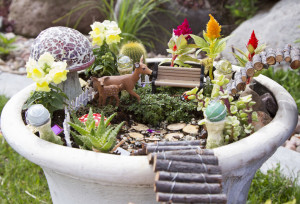Ideas for Planning Your Fairy Garden and Identifying Flowers to Create a Magical Design
 Part of the great fun of reading stories like Thumbelina is the scope for imagination when you try to see the world through the eyes of a tiny sprite or fairy. How small would a fairy chair need to be? How towering would a tulip seem? A fun gardening project to share with kids or grandkids this summer is to create your very own Fairy Garden. We have some tips for identifying flowers and plants that work well in these tiny vistas, all you need to add is enthusiasm and imagination.
Part of the great fun of reading stories like Thumbelina is the scope for imagination when you try to see the world through the eyes of a tiny sprite or fairy. How small would a fairy chair need to be? How towering would a tulip seem? A fun gardening project to share with kids or grandkids this summer is to create your very own Fairy Garden. We have some tips for identifying flowers and plants that work well in these tiny vistas, all you need to add is enthusiasm and imagination.
Scenery Ideas
Before you begin identifying flowers and plants to make your fairy garden you need to decide what kind of scene you wish to create. The happy thing about a fairy garden is that you can make it look how you imagine it. Most scenes tend to look more like a woodsy diorama. These are some scene ideas to get you started:
- A white or blue pebble river
- Wire vine wound onto a miniature archway
- A toadstool house
- A birdhouse
- A miniature house: birchbark or log cabin, tiny stone cottage, colorful Victorian
- A marble atop a golf tee to create a miniature gazing ball
- Tiny deer, rabbit or turtle
Where to Plant
You can plant your fairy garden directly in the ground, but most gardeners prefer a whimsical container for their imaginary garden-scape. If you want your fairy garden to last more than one season consider choosing a container that is at least eight inches deep. If you’re only looking for some summer fun, then keeping things watered and fed will work in less substantial surroundings. Here are a few ideas to spark your thinking:
- An ornamental ceramic dish
- A picnic basket
- A birdbath
- A terra cotta saucer
- A drawer
What to Plant
Scale is the issue when choosing plants. Fortunately, miniature gardeners have gone ahead and paved the way. Here are some of their favorite choices:
For ground cover: baby tears
For shrubbery: dwarf mondo grass, ornamental onion
For trees: English boxwood
For evergreens: Ellwood’s pillar, Wilma Goldcrest Monteray Cypress, Jean’s Dilly
For flowers: pink dianthus, nemesia blue bird and celosia
You can become inspired by looking at the wide variety of pictures of fairy gardens available online. Your local nursery may also have a small section devoted to miniature or fairy garden supplies. However, when it comes to identifying flowers in your fairy garden, there is no better place than Kincaid Plant Markers. Order yours today and start imagining a miniature world of beauty.
